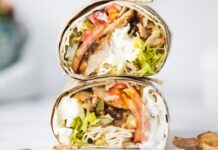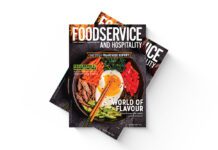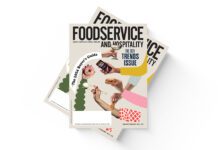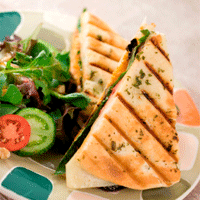With Canadians cutting back on spending as the recession runs its full course, sandwiches and salads enjoy a renaissance
There’s just something about a sandwich that works. Not elegant nor flashy, its lumpy, rarely neat form often looks like a nine-year-old made it, which makes sense in a way, because that’s around the age many kids make their first sandwich — a bond, not set in stone, but between two crustless pieces of Wonder Bread.This underrated, reliable stalwart of diners and delis everywhere gets shunted aside when food-obsessives start lauding the buttery flavour and delicate texture of foie gras, the tenderness of wagyu beef and the rare, earthy essence of black truffles, but even they can’t deny the simple harmonious balance of two slices of freshly baked bread cradling layers of crisp veg, tender meat, tasty cheese and mayo.
Of course, you can always combine those high-end ingredients into one glorious über-sandwich, like chefs at the chic London department store Selfridges did in 2006, when they created an £85 bespoke hoagie made with wagyu beef, fresh lobe foie gras, black truffle mayonnaise, brie de meaux, rocket, red pepper and mustard confit and English plum tomatoes. Surely, every well-heeled shopper on Oxford St. sought out this pre-recession-era butty, the ultimate handheld accessory for London’s upper crust.
But good luck selling that extravagant number these past 12 months, as Europeans and North Americans alike pinched their pennies to help see them through the global economic crisis. If there’s one trend the downturn helped bolster in the current foodservice arena, it’s the fact that ultra-flashy fare is out, at least for now, as comfort food returned to the forefront. And in the realm of foods that comfort the soul, the sandwich is king.
Bun Masters // When news broke this summer that chef Jamie Kennedy — the face of Slow Food in Toronto and champion of sustainable food systems — was financially strapped and scaling back operations at his high-end Gardiner Museum restaurant, and possibly selling off his stake in his eponymous Wine Bar, it shone a bright light on the frailty of the upscale restaurant in tough times. But few critics focused on the fact that Kennedy, for foresight or for kismet, had already opened two casual cafés, The Gilead and Hank’s, to great fanfare. Each featured delicious sandwiches (among other items) in an effort to bring his critically acclaimed cuisine to a broader demographic.
Kennedy opened Gilead about two years ago in Toronto’s Corktown neighbourhood; he had a production kitchen there and needed a place to sell things. The deli counter features house-made goodies like pâtés and terrines, delicious salads, cured and smoked fish, and deli meats sourced from naturally raised animals. “I don’t think he was expecting a lot from Gilead,” says Angie MacRae, Hank’s restaurant manager and self-professed sandwich lover, “but it was a hit immediately. It allowed people to access his food at a different price point. Hank’s was born from that.”
When Hank’s opened last fall in a front room at JK Wine Bar, MacRae says comfort food was making a major resurgence. The recession had everyone in a state of worry as the TSX suffered historic one-day declines. “So we served meatloaf sandwiches and home-cooked things your mom might make — if she were a really good cook. The sandwiches were a little less pristine, a little messier, something you would have to hold with two hands.”
At The Gilead and Hank’s, the menu items and price point may be different, but the JK ethos remains. Product from the same meat producers and responsibly sourced foods are used in the sandwiches, but so are alternative cuts the Wine Bar wouldn’t use, like flank steak. Hank’s flank is marinated in mint and lime and served with smoked sheep’s cheddar, jalapeño mayo, lime acidulated onion and local greens ($5.75/$9.50), proving that Philly isn’t the only town that does steak sandwiches well.
The smoked turkey ($4.50/$7.50) and mushroom ($4/$6.25) sandwiches are the top sellers among its clientele, many of whom are businesspeople no longer lunching in the Wine Bar. “We are seeing that trend for two reasons,” says MacRae. “It’s not fashionable to take a long lunch anymore. So people take it back to their office or eat it quickly. And, even if they haven’t been directly affected by the recession, they’re being conscious of what they spend.”
Hank’s gets its bread every morning from St. John’s bakery. “If you’re serving a sandwich with stale bread it’s unforgivable,” says MacRae. Nevertheless, in her opinion what puts a sandwich over the top is tasty homemade mayo, although every ingredient needs to be balanced. “It has got to have the right balance of textures, too. If you have some really tender meat, then you want something crunchy in there. If you have something really creamy than you need some acidity.”
A new trend also emerged over the past year as talented Toronto chefs focused on increasingly casual dining concepts. Marc Thuet closed his Atelier Thuet restaurant in Toronto’s Liberty Village and recently opened a second Petite Thuet café downtown at King at Yonge, around the corner from Hank’s. There, Thuet showcases a range of tasty sarnies served on his famous bread, such as Mennonite-farmed capon club on brioche and roasted vegetables, hummus, eggplant caviar on multi-grain bread. Kennedy’s repositioned museum location now offers a fancy ham sandwich for lunch.
The gastropub is another restaurant concept that’s on the rise in Hogtown, with popular neighbourhood joints like Prohibition, The Adelaide St. Pub and The Queen and Beaver featuring sandwiches and other dishes inspired by trips to well-mannered alehouses in England. (Customers should be prepared to leave the darts at home.)
Regardless of how casual it gets, culinary craftsmen like Kennedy and Thuet understand that a lot of love goes into making a great sandwich. It needs to be well-thought out, with all of the elements accounted for like fresh ingredients, consciously matched, and it must be made to order. But that doesn’t mean fast-food outlets can’t follow suit. “Oddly enough, I give some credit to Subway for pushing the sandwich forward,” admits MacRae. “That’s where they really took off. They made things to order; they didn’t have items under cellophane just sitting there. It’s interesting; at JK we love to hate fast-food chains but once in a while they can hit the nail on the head.”
While Subway may have changed the quick-service sandwich game [and pushed back against the recession by offering an array of $5 footlongs, a trend that quickly caught on this year] a newcomer on the scene is working hard to revolutionize it. In the U.S., Panera Bread continued expanding into new markets — recession be damned — offering customers tasty, healthy sandwiches made on fresh-baked bread. It opened a swath of new stores over the past year and posted same-store sales growth of 3.4 per cent. Its stock value increased by an incredible 50 per cent.
Craig Milne, franchisee of the three Panera Bread locations in the GTA, says Canadians have had no problem paying a bit more for Panera’s high-quality, healthful sandwiches. “They understand that we use smoked turkey, Black Forest ham, Angus roast beef, antibiotic-free chicken and all fresh meats,” he says. “And when they’re eating one of our sandwiches, they know the bread is baked fresh in-house, every day. There’s not one [QSR] competitor out there that can compete with us on bread.”
Panera ran a feature on its asiago roast beef sandwich a few months back and it was a bestseller. “The bacon turkey bravo is another strong performer,” he says, noting the popularity of certain items depends on the market as well as the daypart. “We tend to sell heavier sandwiches at night.” They range in price from $6.99 to $8.99, but Panera also has a unique feature called ‘You Pick Two’ that’s popular with customers. For $7.99, guests have the ability to pick any two combinations of half sandwich, half soup and half salad. Milne claims about 70 per cent of guests opt for the combo — an impressive upselling feat.
Providing bang for your buck has always been a defining characteristic of the sandwich. If you look back through history, it’s been a popular item during difficult economic times. Take the famed Po’ Boy sandwich, which some say has its roots in early depression-era New Orleans, where striking railway workers were looking for a cheap meal. At Dadeo’s 1950s-style diner in Edmonton, the Po’ Boy is alive and well. “It’s a New Orleans staple, similar to a French loaf with a crunchy outside and a soft inside,” says Karen Thiessen, co-owner of Dadeo’s, which pumps out 5,500 Po’ Boys a month. “It’s like a stuffed baguette but it differs from other sandwiches because it often has seafood in it like catfish, oysters and crab.”
Thiessen says Dadeo’s top-selling Po’ Boys are its blackened chicken, pulled pork and blackened catfish, the latter featuring fish sourced from Louisiana. They sell for $11 and come with coleslaw and a choice of potato hash, tomato rice or sweet potato fries. She believes customers love sandwiches for their simplicity. “It goes back to the origin of the Po’ Boy. They’re cheap, they fill you up, they can be hot or cold and you can put loads of different toppings on them. There’s just something comforting about a sandwich.”
Salad Days // Balance, as it is with any complex entrée or great sandwich, is key to a good salad as well. At the Vineland Estates winery restaurant in Jordan, Ont., executive chef Jan-Willem Stulp uses local cherries and other produce in his salads, when in season, for their ultra-fresh flavour but also to capture a sense of the terroir of the region. “When you buy local, you harness a philosophy people are excited about,” says Stulp. He also stresses a simple reason for sourcing local: “When fruit is picked away from where it is to be consumed, it’s picked for how well it travels and its shelf-life. It’s not ripe. When I order fruit, it’s picked to eat.”
He also uses wine in many of his dressings and vinaigrettes — lobster salad is finished off with vanilla/Chardonnay syrup, which pairs perfectly with Vineland’s exquisite Chardonnay Reserve. “Salads, particularly with vinaigrettes, are the complete counterpoint to wine. If you have anything that acidic in your mouth, go try and find a wine that’s going to work with it. So we work toward more benign flavours in our dressings, to help us bring out the better parts of a salad that pair with our wines.” He’s even been known to scoop out the liquid that gathers on top of yogurt to use in place of vinegar, because “it has a beautiful zip to it.”
At Le Select Bistro in Toronto, executive chef Albert Ponzo adds protein to his lunch menu salads because many of his loyal customers only have 45 minutes to eat and they want an item that will still fill them up. The hearty Landaise has shredded duck confit, tomatoes, walnuts and sherry vinaigrette, but Ponzo’s favourite salad is the Oreille Du Cochon, which was inspired by a trip to Spain. It features crispy sow’s ear strips served over lentils Du Puy and watercress. “The watercress is bitter but the red peppers are sweet and they round out the flavour. The pig’s ears are crispy and they add nice contrast to the salad, while the acidity of the lentils with the sherry vinaigrette cuts the fat. It’s a really well-balanced salad.”
Salad is also increasingly popular among diners at QSRs. When Wendy’s first began offering large salads loaded with chicken, they were an immediate hit. Other chains followed suit, including McDonald’s and Tim Hortons. McDonald’s recently introduced four chicken-based entrée salads — the Mediterranean, mighty caesar, spicy Thai and garden fresh — paired with gourmet dressings and selling for $6.79. Not to be outdone, Panera offers a selection of leafy plates that attract health-conscious customers, including grilled chicken caesar, fuji apple chicken and Asian sesame chicken. And quick-service concept The Lettuce Eatery is immensely popular, with 15 units in Toronto and the U.S. and upwards of 100 more in development. It’s built a very successful business on the premise of a smaller, economical footprint featuring fancy salad. Who knew?
Homer Simpson famously said, “You can’t make friends with salad,” but with a growing number of customers happily ordering leafy greens for lunch, it seems he was mistaken.




















